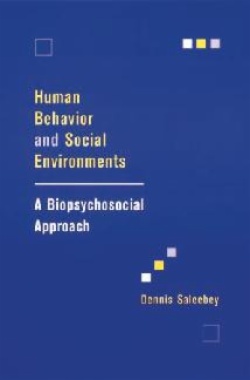Human behavior is a subject so vast that it would seem to defy one's ability to comfortably and confidently grasp its varieties, nuances, shapes, and dynamics. But in this wide-ranging and comprehensive survey of the contexts of human behavior, Dennis Saleebey examines the different social science approaches to understanding the way humans react to and are affected by their environment.
Using a biopsychosocial perspective, this book demonstrates that there are many paths of knowledge, many methods of inquiry, and many perspectives that can guide one's understanding of human behavior. Resilience (how we cope with trauma) and meaning-making (how we see and make sense of the world around us) provide the conceptual framework of the book. Saleebey examines a number of specific theories relevant to the biopsychosocial approach: part/whole analysis, psychodynamic theory, ecological theory, cognitive theory, and radical/critical theory. Human development is presented as a continuing interaction between individual, family, community, social institutions, and culture. Pedagogical devices to aid the student include chapter overviews, case studies, and meaning-making dialogues at the end of each chapter that pose questions for further thought.
- Contents
- Preface
- Acknowledgments
- CHAPTER ONE Introduction
- Philosophical Principles
- Conceptual Frameworks
- Integrative Themes
- Paradigms, Postmodernism, and Possibilities
- M and M Dialogue
- CHAPTER TWO Meaning-Making
- Self
- Culture
- Story, Connection, Ritual, and Myth
- M and M Dialogue
- CHAPTER THREE Strengths and Resilience
- Strengths and Reslilience: Images of Altruism and Humanity
- M and M Dialogue
- CHAPTER FOUR Biopsychological Understanding
- Human Nature and the Human Condition
- Genes and Experience: The Case of Temperamet
- The Brain and Behavior: The Biopsychosocial View
- Conclusion
- M and M Dialogue
- CHAPTER FIVE Nature and Nurture, Neurons and Narratives: Putting It All Together
- Nature and Nurture: How Necessary are Parents?
- Neurons and Narratives: A Biospychosocial Understanding of Mental Illness
- Conclusion
- M and M Dialogue
- CHAPTER SIX Theories: Part I
- The Elements of Theory
- Psychodynamic Theory
- M and M Dialogue
- CHAPTER SEVEN Theories: Part II
- Ecological Theory
- Cognitive Theory
- Conclusion
- M and M Dialogue
- CHAPTER EIGHT Person/Environment, Part I: Families - The Variety of Us
- The Family and Society Today: What's Up?
- What are Families For?
- Family Resilience
- Conclusion
- M and M Dialogue
- CHAPTER NINE: Person/Environment, Part II: Coming Into Being in the Family and Community
- A Contextual Model of Family Transition and Adaptation
- Becoming Partners and Being a Couple
- A New Human Being Joins the Family
- When Things Go Awry
- Conclusion
- M and M Dialogue
- CHAPTER TEN Person/Environment, Part III: Growing Up in Family and Community
- Middle Childhood: The Forgotten Years
- Conclusion
- M and M Dialogue
- CHAPTER ELEVEN Person/Environment, Part IV: Coming of Age in Family and Community
- Sturm und Drang or The Romance of Risk?
- Conclusion
- M and M Dialogue
- CHAPTER TWELVE Person/Environment Part V: Maturing and Aging in Family and Community
- Maturity: Love, Work, Connection, and Closure
- Some Important Moments in Adult Life
- Coming of (Older) Age in America
- Conclusion
- M and M Dialogue
- CHAPTER THIRTEEN Reprise, Vision, and the Final Conversation
- Reprise
- So What is The Good Life, Anyway?
- Conclusion
- The Final M and M Dialogue
- Index

